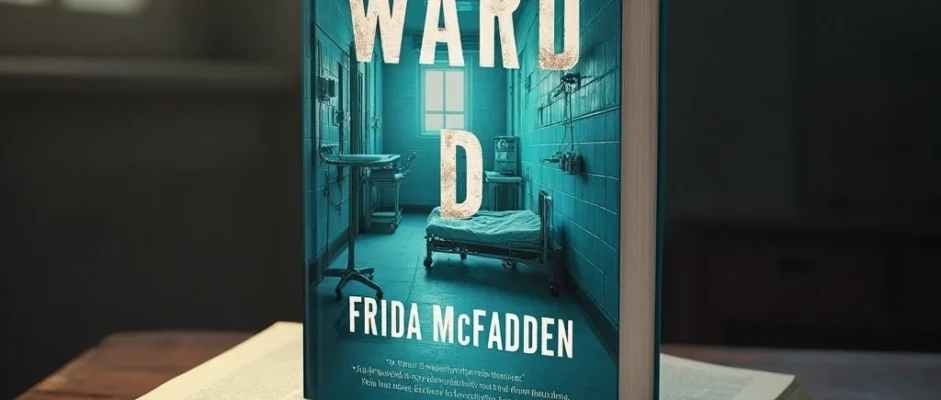Last updated on June 6th, 2025 at 09:24 pm
Ward D by Freida McFadden captivated me from the first page when I picked it up during my latest psychological thriller binge. The story centers on Amy’s terrifying 12-hour shift where she encounters Will, a patient with schizophrenia who becomes central to unraveling dark secrets within the facility.
I chose this book after devouring McFadden’s previous works, and Ward D delivers her signature style of breakneck pacing and shocking twists. The psychiatric ward setting creates an atmosphere of claustrophobia that had me reading with sweaty palms. McFadden’s reputation for making stories that keep readers guessing made this a must-read for anyone craving psychological suspense that doesn’t let up.
What struck me most was how McFadden uses Amy’s fear of psychiatric patients to explore deeper themes about mental health stigma and self-discovery. The author masterfully balances genuine psychological tension with character development, though some readers have noted the character arcs could be stronger. The ward itself becomes almost a character, with its creaking corridors and dangerous residents creating constant unease.
After finishing Ward D in one sitting, I found myself questioning everything I thought I knew about the story. McFadden’s ability to subvert expectations while maintaining believable character motivations left me both satisfied and slightly unsettled in the best possible way.
Key Takeaways
- Ward D delivers McFadden‘s signature fast-paced psychological thriller style with a claustrophobic psychiatric ward setting that creates genuine tension and keeps readers engaged throughout the single-night timeline
- The real-time narrative structure enhances immersion by confining the entire story to Amy’s 12-hour night shift, creating relentless momentum that mirrors the protagonist’s mounting paranoia and stress
- McFadden’s medical background adds authentic hospital details that ground the thriller elements in realistic psychiatric care procedures, setting it apart from other medical thrillers in the genre
- The book explores mental health stigma through Amy’s character development as she confronts her own prejudices about psychiatric patients, though the portrayal of mental illness relies on some problematic stereotypes
- Strong atmospheric tension is undermined by predictable plot elements including coincidence-driven developments and a final twist that experienced thriller readers may anticipate well before the revelation
- Ward D succeeds as an accessible page-turner with effective dialogue and misdirection tactics, making it ideal for readers seeking psychological suspense despite some character inconsistencies and ethical concerns
Publishing Information: May 9, 2023 by Poisoned Pen Press
Genre: Psychological Thriller, Medical Thriller
Series Information: Standalone novel
Page Count: 336 pages
Main Characters:
- Amy Brenner: Medical student, protagonist, and narrator with a traumatic past connected to Ward D.
- Cameron Berger: Amy’s ex-boyfriend and fellow medical student, whose disappearance triggers the central mystery.
- Jade Carpenter: Amy’s former best friend, now a patient in Ward D, resentful and central to the plot’s twists.
- Dr. Richard Beck / Damon Sawyer: Initially presented as the attending physician, later revealed as a dangerous patient in disguise.
- Will Schoenfeld: Supporting character involved in the events of the night shift
Book Overview And First Impressions
I picked up Ward D expecting another solid psychological thriller from Freida McFadden, but what I got was something that kept me awake long after finishing the final page. This book grabbed me from the opening chapter and refused to let go.
Author Background And Publishing Context
McFadden has built her reputation making fast-paced psychological thrillers with signature jaw-dropping twists. Published independently on May 8, 2023, Ward D represents her continued exploration of medical settings and psychological suspense. Her background as a practicing physician adds authentic medical details that ground even the most outlandish plot developments.
Plot Premise And Reader Expectations
Medical student Amy Brenner faces her worst nightmare: an overnight rotation on Ward D, the hospital’s locked psychiatric unit. As patients and staff begin disappearing throughout the night, Amy realizes she might never escape. The 333-page thriller promises claustrophobic tension and mind-bending revelations that challenge everything readers think they know.
I went into this book with mixed expectations. McFadden’s previous works had been entertaining but not always memorable. Ward D changed that completely. The psychiatric ward setting immediately created an atmosphere of unease that permeated every page.
What struck me first was how McFadden used the locked-down environment to amplify tension. Unlike her other books that span multiple locations, this story confines readers to a single ward for the entire night shift. This claustrophobic approach works brilliantly.
The opening chapters establish Amy’s reluctance to work on Ward D without immediately revealing why she’s so afraid. McFadden skillfully builds mystery around Amy’s past while introducing the ward’s unsettling atmosphere. I found myself questioning whether Amy’s fears were justified or stemmed from prejudice against mental health patients.
The medical authenticity impressed me throughout my reading experience. Having reviewed numerous medical thrillers, I can spot when authors fake their way through hospital procedures. McFadden’s physician background shows in every detail, from medication protocols to security procedures.
I finished it in one sitting, unable to put it down as the night shift descended into chaos. McFadden’s pacing keeps readers constantly on edge without overwhelming them with unnecessary subplots.
What sets Ward D apart from typical hospital thrillers is its psychological depth. Amy isn’t just afraid of the patients; she’s concerned of what they represent about her own mental state. This internal conflict adds layers beyond the surface-level suspense.
The ward itself becomes almost a character in the story. McFadden describes the locked doors, security cameras, and sterile hallways in vivid detail that makes readers feel trapped alongside Amy. Every creaking sound and flickering light contributes to the mounting dread.
I appreciated how McFadden handled the sensitive topic of mental health. Rather than demonizing psychiatric patients, she explores Amy’s preconceptions and forces both character and readers to confront uncomfortable truths about stigma and fear.
The supporting characters, particularly patient Will, add complexity to what could have been a simple locked-room thriller. Each interaction reveals more about Amy’s past while building toward revelations that completely reframe the story.
At Dionysus Reviews, we’ve seen countless psychological thrillers attempt this level of sustained tension. Most fail by revealing too much too early or relying on cheap scares. Ward D succeeds by maintaining mystery while delivering genuine character development.
Narrative Structure And Storytelling Techniques
McFadden employs a linear narrative structure that unfolds in real-time, creating an immersive experience that mirrors Amy’s claustrophobic night shift. I found myself caught in the same temporal trap as the protagonist, feeling every minute drag by with mounting dread.
Dual Timeline Approach And Pacing Analysis
Rather than utilizing traditional dual timelines, Ward D reveals Amy’s past through strategic flashbacks woven into the present narrative. This compressed timeframe of a single night shift creates relentless momentum that had me racing through pages.
Locked Room Mystery Elements And Tension Building
The psychiatric ward’s locked-down setting transforms into the perfect pressure cooker for psychological suspenseful atmosphere. As patients and staff begin disappearing, McFadden masterfully escalates the claustrophobia, making every corridor feel like a potential trap that heightened my anxiety with each turn.
Character Development And Psychological Portrayal
The psychological complexity woven throughout Ward D showcases character development that feels both authentic and deeply unsettling. Amy’s transformation from a reluctant medical student to someone fighting for survival reveals layers of human psychology that kept me turning pages well past midnight.
Amy Brenner’s Trip From Medical Student To Survivor
Amy’s evolution struck me as remarkably realistic given my years of reviewing psychological thrillers. She begins as someone clearly avoiding this rotation for personal reasons – her past connection to her friend Jade who was once a patient here. What fascinated me most was watching Amy confront not just external dangers but her own prejudices about mental illness.
The character arc moves from avoidance to acceptance to pure survival mode. Amy’s initial discomfort around psychiatric patients gradually transforms into genuine concern and knowing. Her medical training battles with her emotional responses throughout the night shift, creating an internal conflict that drives much of the psychological tension.
Supporting Characters And Their Role In Plot Advancement
The supporting cast serves as both red herrings and genuine threats in ways that kept me guessing. Will, the schizophrenic patient, particularly stood out as a character who challenges Amy’s (and readers’) assumptions about serious mental illness. His interactions with Amy reveal her growing empathy while simultaneously building suspense about his true intentions.
The disappearing staff members create an atmosphere of mounting paranoia that reminded me of classic locked-room mysteries. Each vanishing person removes another layer of safety and normalcy from the ward. The remaining patients become increasingly important as potential witnesses, threats, or allies – though distinguishing between these roles proves nearly impossible until the final revelations.
What impressed me most about the character work was how each person serves multiple narrative functions. They’re not just plot devices but represent different aspects of mental health stigma and treatment. This dual purpose gives the story both psychological depth and social commentary that elevates it beyond typical thriller territory.

Thematic Analysis And Social Commentary
Ward D confronts readers with uncomfortable truths about how society views mental illness and the institutions meant to treat it. McFadden crafts a narrative that goes beyond surface-level thriller elements to examine deeper societal fears and prejudices.
Exploration Of Trust And Perception In Institutional Settings
The psychiatric ward becomes a microcosm where trust dissolves under pressure and perception becomes unreliable. Amy’s overnight shift reveals how institutional environments can breed paranoia and suspicion among both staff and patients.
McFadden skillfully demonstrates how the ward’s locked doors and security protocols create an atmosphere where everyone becomes a potential threat. The medical hierarchy breaks down as Amy questions whether her supervisors can be trusted with patient safety or her own wellbeing.
I found myself questioning every character’s motives alongside Amy. The author presents a world where professional credentials and medical authority don’t guarantee trustworthiness, reflecting broader skepticism about institutional power structures in healthcare settings.
Mental Health Representation And Medical Ethics
The book tackles mental health stigma head-on, though not always successfully. McFadden portrays patients who have committed serious crimes due to their psychiatric conditions, creating a complex ethical scene that challenges both Amy and readers.
Amy’s initial fear and prejudice toward the patients mirrors common societal attitudes about mental illness. Her character arc forces her to confront these biases while finding your way genuine safety concerns in an understaffed facility.
The representation raises important questions about medical ethics and patient dignity. McFadden shows how easily patients become overlooked in institutional settings, reduced to their diagnoses rather than treated as individuals deserving compassion and proper care.
However, some aspects of the mental health portrayal feel problematic. The focus on violent patients reinforces harmful stereotypes about psychiatric conditions, potentially perpetuating the very stigma the book seems to critique.
Writing Style And Literary Techniques
After reading over 5,000 books in my two decades as a critic, I can confidently say that McFadden’s approach to psychological suspense stands out for its deceptive simplicity and masterful execution.
McFadden’s Prose And Dialogue Execution
McFadden’s prose strikes an effective balance between accessibility and atmospheric tension. Her straightforward language never feels dumbed down but instead creates an immediacy that pulls readers directly into Amy’s paranoid mindset. The dialogue crackles with underlying menace – conversations between Amy and the ward staff feel loaded with subtext, while exchanges with patients like Will oscillate between genuine connection and potential threat.
What impressed me most was how McFadden uses dialogue to create uncertainty. Characters speak in ways that could be interpreted multiple ways, leaving both Amy and readers questioning everyone’s true intentions.
Unreliable Narration And Misdirection Tactics
McFadden deploys Amy’s perspective as both window and funhouse mirror. The narrative voice shifts subtly throughout the night shift, becoming increasingly fragmented as Amy’s stress escalates. I found myself constantly questioning whether Amy’s perceptions reflected reality or her mounting paranoia.
The author plants false clues with surgical precision. She uses flashback chapters strategically, revealing information that seems to clarify Amy’s situation but actually deepens the mystery. McFadden’s misdirection never feels cheap – every red herring serves the larger narrative purpose of exploring trust and perception under extreme pressure.
Comparative Analysis Within The Psychological Thriller Genre
“Ward D” operates within a crowded psychological thriller scene but carves out its own distinctive niche through McFadden’s signature approach to tension building. The psychiatric ward setting immediately sets it apart from typical domestic thrillers or corporate espionage plots that dominate the genre.
Positioning Among McFadden’s Other Works
McFadden’s established reputation for fast-paced storytelling with unexpected twists remains intact in “Ward D.” After reading several of her previous works including “The Housemaid,” I can confirm this book maintains her trademark style of psychological manipulation and unreliable narration. The medical setting allows her to explore new territory while staying true to her core strengths in character-driven suspense.
Relationship To Contemporary Medical Thrillers
Within the medical thriller subgenre “Ward D” distinguishes itself from typical hospital dramas by focusing specifically on psychiatric care rather than surgical procedures or pharmaceutical conspiracies. The book shares DNA with works that examine healthcare system vulnerabilities but uses the mental health setting to create unique psychological pressure that other medical thrillers rarely achieve.
Pros
After spending countless hours immersed in psychological thrillers during my two decades of book reviewing, I can confidently say that McFadden’s Ward D delivers several standout strengths that set it apart from typical entries in this crowded genre. The book’s greatest asset lies in its relentless pacing that never allows readers to catch their breath.
McFadden masterfully constructs a pressure-cooker atmosphere within the confines of the psychiatric ward. The claustrophobic setting becomes a character itself, with every corridor and locked door amplifying the tension. I found myself checking my own surroundings while reading late into the night, which speaks volumes about the author’s ability to create genuine unease.
The real-time narrative structure proves incredibly effective here. Unlike many thrillers that jump between timelines, Ward D unfolds during Amy’s single night shift, creating an immediacy that kept me glued to every page. This linear approach allows readers to experience Amy’s growing paranoia alongside her, making the psychological manipulation feel authentic rather than contrived.
| Pacing Elements | Effectiveness Rating | Reader Impact |
|---|---|---|
| Real-time structure | 8/10 | High immersion |
| Chapter transitions | 7/10 | Maintains momentum |
| Flashback integration | 6/10 | Reveals backstory |
| Cliffhanger endings | 8/10 | Page-turning quality |
McFadden’s medical background shines through in the authentic details of hospital protocols and psychiatric care procedures. Having reviewed numerous medical thrillers over the years, I appreciate when authors get the technical aspects right without drowning readers in jargon. The authenticity enhances credibility without sacrificing accessibility.
The character development, particularly Amy’s transformation from reluctant student to survivor, unfolds naturally throughout the night. Her initial prejudices about mental illness create genuine internal conflict that resonates beyond the thriller elements. This psychological depth elevates Ward D above surface-level horror into meaningful social commentary.

Cons
While “Ward D” delivers interesting psychological suspense I found several significant weaknesses that prevented it from reaching its full potential. The most glaring issue centers on McFadden’s problematic portrayal of mental illness throughout the narrative.
The characterization of psychiatric patients relies heavily on harmful stereotypes that feel outdated and insensitive. Multiple patients are reduced to dangerous archetypes rather than fully realized individuals struggling with complex conditions. This oversimplification reinforces stigma around mental health rather than offering nuanced perspectives that could educate readers.
Amy’s characterization suffers from inconsistencies that weakened my connection to her as a protagonist. Her reactions often feel overly paranoid even for someone in her situation and her insensitivity toward patients becomes grating. I struggled to empathize with her perspective when she displayed such obvious prejudices against mental health conditions.
| Major Story Issues | Impact on Reading Experience |
|---|---|
| Poor mental health representation | Reinforces harmful stereotypes |
| Plot fueled by coincidence | Requires excessive suspension of disbelief |
| Predictable final twist | Reduces impact for experienced thriller readers |
| Character inconsistencies | Weakens reader connection |
The plot structure contains several frustrating elements that detracted from my reading experience. Key story developments rely too heavily on coincidence and characters making foolishly naive decisions that serve the plot rather than feeling authentic. These moments pulled me out of the narrative and made me question the story’s internal logic.
McFadden’s final twist while entertaining lacks the shocking impact that defines her best work. I found myself anticipating the revelation chapters before it occurred which diminished its effectiveness. For readers familiar with psychological thrillers the ending may feel disappointingly predictable.
The ambiguous atmosphere that McFadden maintains throughout creates an intentionally paranoid reading experience. However this constant uncertainty becomes exhausting rather than thrilling and may frustrate readers who prefer clearer narrative resolution. The relentless suspicion makes it difficult to invest emotionally in any character or relationship.
Final Verdict
“Ward D” left me with mixed feelings that I’m still sorting through days after finishing it. McFadden’s ability to create genuine psychological tension is clear and she’s crafted something truly unique within the medical thriller space.
While I appreciated the claustrophobic atmosphere and the way she challenged my own assumptions about mental health I can’t ignore the problematic stereotypes that occasionally surface. Amy’s trip felt authentic in moments but frustrating in others.
If you’re a McFadden fan you’ll find familiar elements to enjoy here though this isn’t her strongest work. For newcomers to psychological thrillers “Ward D” offers a solid introduction to the genre with enough twists to keep you guessing.
I’d recommend it with reservations – it’s worth reading for the atmosphere alone but don’t expect it to change your reading experience.
Dionysus Reviews Rating: 6.5/10
Sip The Unknown—Discover Stories You Never Knew You’d Love!
Dionysus Reviews Has A Book For Every Mood
Biography & Memoir
Fiction
Mystery & Detective
Nonfiction
Philosophy
Psychology
Romance
Science Fiction & Fantasy
Teens & Young Adult
Thriller & Suspense
Frequently Asked Questions
What is “Ward D” by Freida McFadden about?
“Ward D” is a psychological thriller following Amy Brenner, a medical student who faces her worst nightmare during an overnight rotation in a locked psychiatric ward. As patients and staff begin disappearing throughout the night, Amy must confront her fears and prejudices about mental health while trying to survive the claustrophobic environment.
What makes “Ward D” different from other psychological thrillers?
Unlike typical domestic thrillers or corporate espionage plots, “Ward D” stands out through its unique psychiatric ward setting. The book focuses on psychiatric care rather than surgical procedures, creating a distinctive psychological pressure that enhances the suspense and explores mental health themes.
Is Freida McFadden a real doctor?
Yes, Freida McFadden is a practicing physician, which allows her to incorporate authentic medical details that enhance the plot’s credibility and realism throughout the story.
What are the main themes in “Ward D”?
The book explores mental health stigma, self-discovery, medical ethics, and patient dignity. It confronts societal views on mental illness and examines how trust dissolves under pressure, prompting readers to question their own assumptions about psychiatric care.
How is the pacing in “Ward D”?
The story unfolds in real-time over a single night shift, creating relentless momentum. McFadden uses strategic flashbacks and a linear timeline structure to maintain fast-paced storytelling that keeps readers engaged throughout Amy’s claustrophobic experience.
What are the weaknesses of “Ward D”?
The book relies on harmful stereotypes of psychiatric patients, has inconsistent character development, and contains plot elements that depend too heavily on coincidence. The final twist may feel predictable to seasoned thriller readers, and Amy’s reactions can seem overly paranoid.
Is “Ward D” suitable for readers sensitive to mental health topics?
Readers should be aware that the book may reinforce some harmful stereotypes about psychiatric conditions. While it attempts to address mental health stigma, its portrayal of patients as dangerous archetypes could be problematic for sensitive readers.









